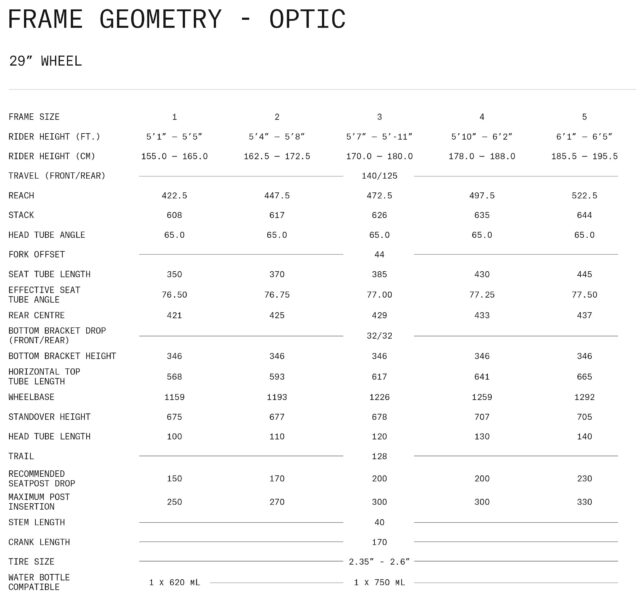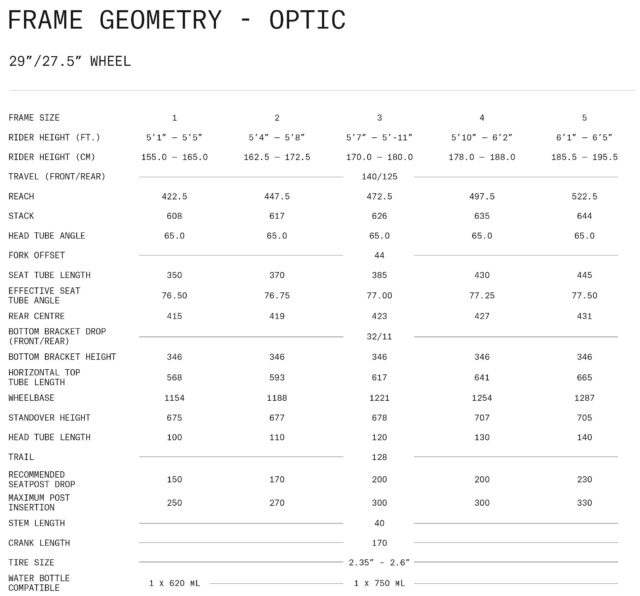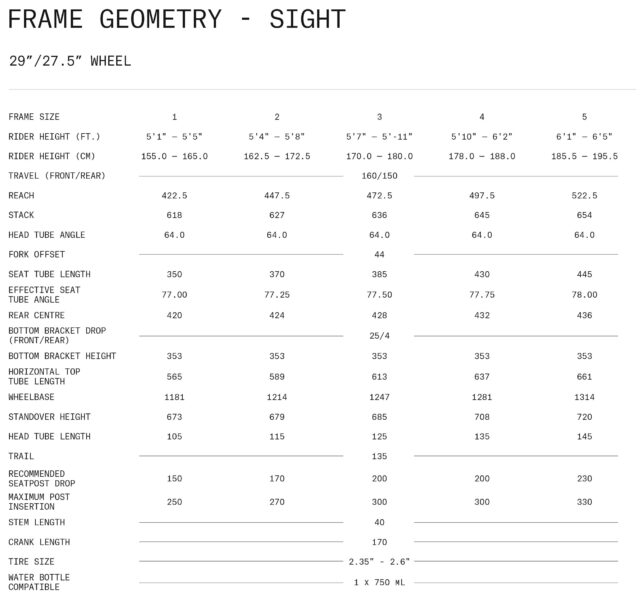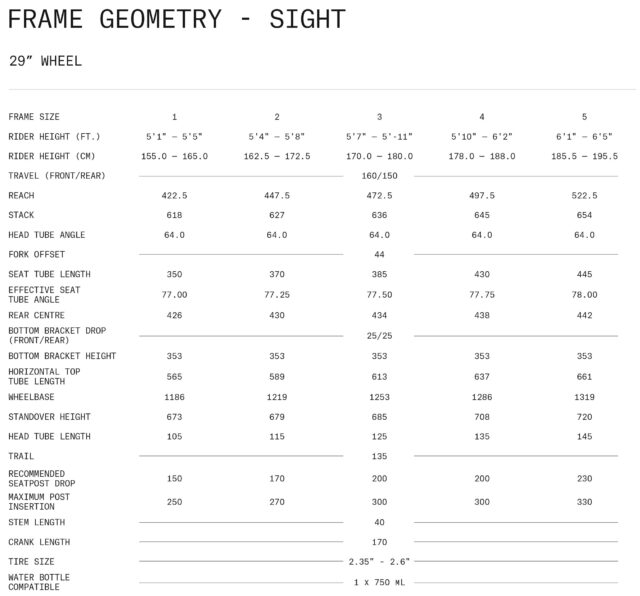Wheel Size: 29’’ front / 29’’ or 27.5’’ rear
Travel: 125 mm rear / 140 mm front
Geometry Highlights:
- Sizes Offered: 1, 2, 3, 4, 5
- Headtube Angle: 65°
- Seat Tube Angle: 77° (size 3)
- Reach: 472.5 mm (size 3)
- Chainstay Length: 429 mm (29’’) or 423 mm (MX); Size 3
Frame Material: Aluminum and carbon fiber versions available
Price:
- Aluminum frame w/ RockShox Vivid Select+ shock: $2,099 USD / $2,399 CAD
- Carbon frame w/ RockShox Vivid Select+ shock: $3,849 / $4,999 CAD
- Complete bikes: $6,999 to $9,099 USD / $5,399 to $11,499 CAD
Wheel Size: 29’’ front / 29’’ or 27.5’’ rear
Travel: 150 mm rear / 160 mm front
Geometry Highlights:
- Sizes Offered: 1, 2, 3, 4, 5
- Headtube Angle: 64°
- Seat Tube Angle: 77.5° (size 3)
- Reach: 472.5 mm (size 3)
- Chainstay Length: 434 mm (29’’) or 428 mm (MX); Size 3
Frame Material: Aluminum and carbon fiber versions available
Price:
- Aluminum frame w/ RockShox Vivid Ultimate shock: $2,399 USD / $2,199 CAD
- Carbon frame w/ RockShox Vivid Ultimate shock: $3,999 USD / $5,149 CAD
- Complete bikes: $3,999 to $7,499 USD / $5,049 to $12,999 CAD
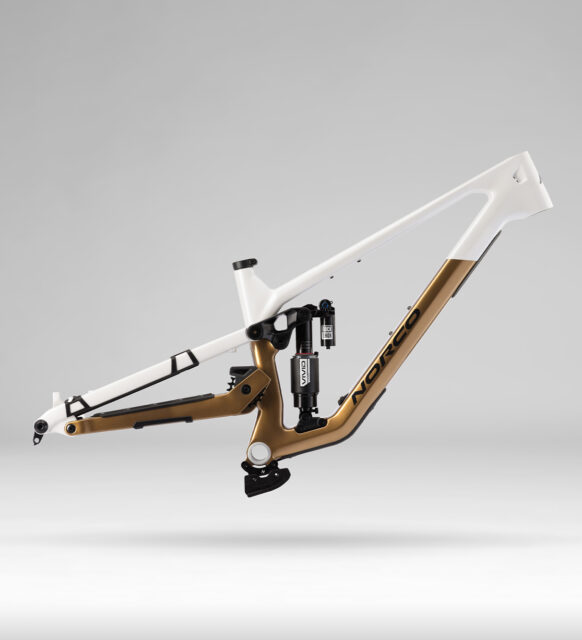
Intro
A lot of recent bike releases have felt like minor refreshes rather than big overhauls of a given model. This is largely due to the fact that the geometry revolution of the late 2010s / early 2020s has largely settled down, though companies are still refining the details, and I’m convinced that a move to taller stack heights and longer chainstays on more gravity-oriented bikes is going to keep trickling in. That said, lately, a lot of companies are content to slap on a UDH if their prior-generation bike didn’t have one, maybe add downtube storage, make some minute tweaks to the geometry, and call it good.
Norco thought about doing a similarly subtle touch-up on the Optic and Sight… and then did something else entirely. So let’s see what they came up with:
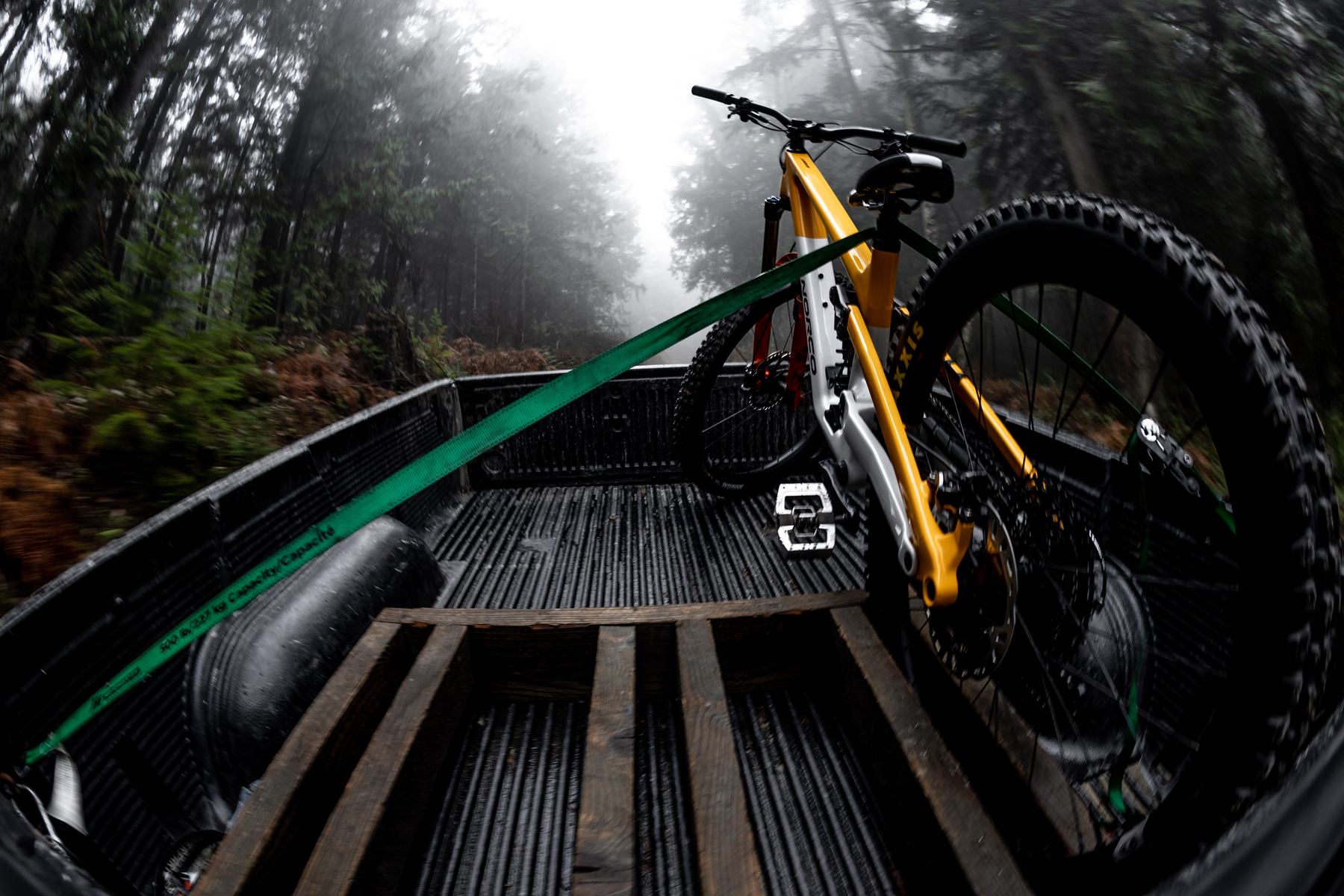
The Frames
As with the prior-generation Optic and Sight, the design of the two new frames is quite similar, with the two sharing similar suspension layouts, overall silhouettes, and so on. And that suspension layout is the most obvious change from the prior-generation bikes — both the Sight and the Optic have gone high-pivot.
Norco, of course, isn’t new to high-pivot designs. There’s the Norco Aurum HSP of old, the current Range and Shore, and the prototype DH bike that Greg Minnaar, Gracey Hemstreet, and Lucas Cruz are racing. But the Optic and Sight’s layout is pretty different from any of those other bikes. Norco calls it “VPS HP” and it’s effectively a Horst-link setup with a vertically-oriented shock, but with the main pivot moved up and an idler pulley added to handle the resulting more rearward axle path.
Unlike the Shore, which uses a visually similar layout, the Optic and Sight attach the idler pulley to the chainstay, offset from their main pivot. Doing so required Norco to license the i-Track suspension patent; that patent effectively governs a high-pivot layout where the idler is attached to a part of the frame other than the front triangle or the member that the rear axle is attached to. Going this route allowed them to tune the pedaling characteristics of the new bikes independently of the other kinematic variables to a degree that wasn’t possible otherwise.
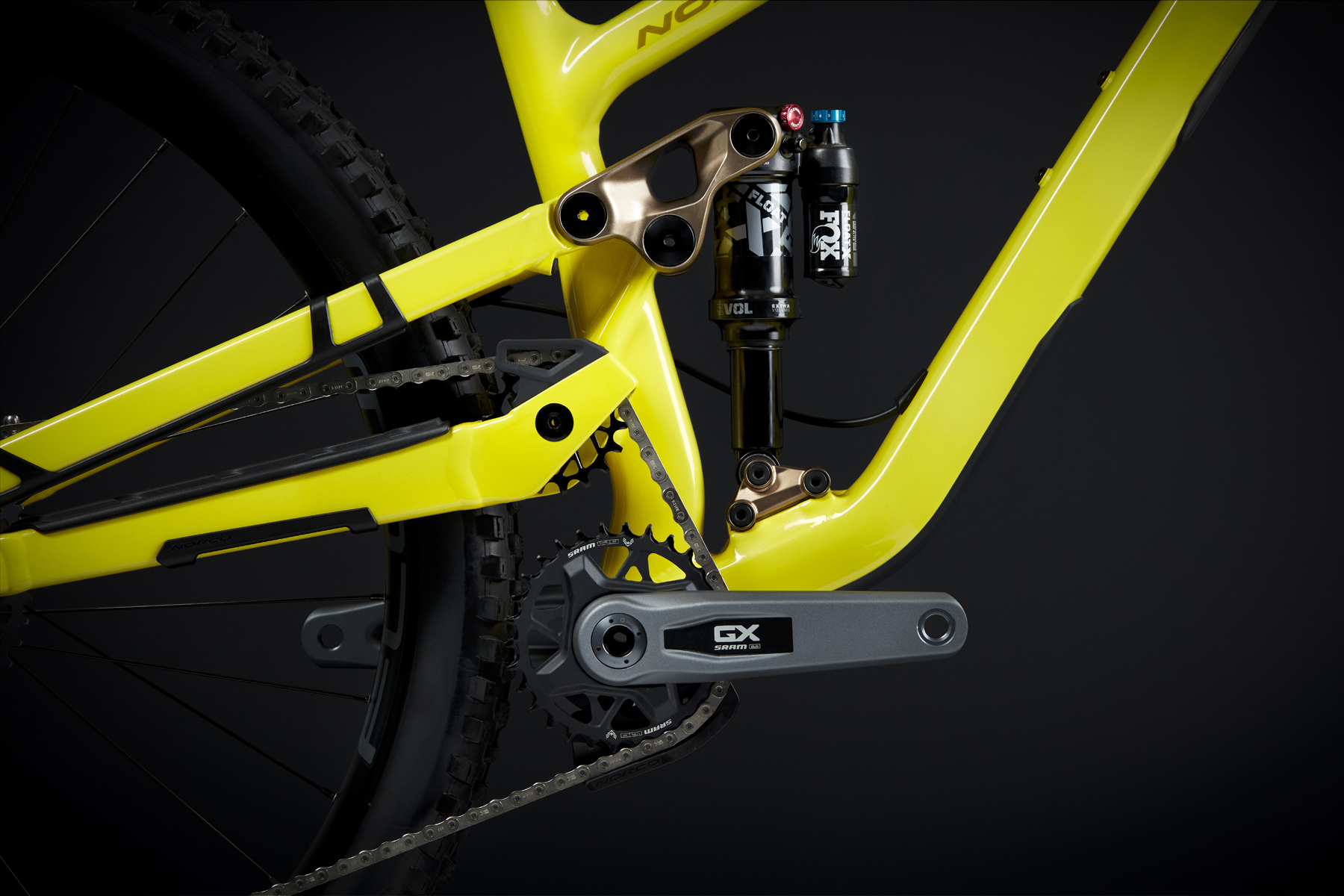
Norco hasn’t changed the suspension travel on either bike — it’s 125 mm rear / 140 mm front on the Optic, and 150 mm rear / 160 mm front on the Sight. But they have made some changes to the suspension kinematics, in addition to making the axle path more rearward. They’ve increased the amount of progression in the leverage curve on both bikes to make them less reliant on rear-shock volume spacers for bottom-out resistance, and they’ve lengthened the rear shock strokes (to 50 mm on the Optic and 60 mm on the Sight) to lower the overall leverage ratio on both.
Norco doesn’t publish specific kinematic graphs for the new bikes but says that the pedaling performance feels similar to the outgoing models. The Optic apparently has a little more anti-squat than the Sight.
[If you want to hear a whole lot more about the new bikes, check out Ep.211 of Bikes & Big Ideas with Norco engineer Colin Ryan. We do a deep dive into a whole lot of the design, development, and testing of the new bikes in greater detail, and it’s very much worth a listen if you want to learn more.]
Both the new Optic and the Sight are now available in aluminum or carbon fiber frame options (the prior-gen Optic was carbon only), and the carbon frames now have carbon chainstays to match, in contrast to the aluminum chainstays of the prior-gen versions. The bottom bracket shells are threaded, the cable routing is internal (and fully guided on the carbon frames), and extensive co-molded rubber guards are included on the chainstay, seatstay, and downtube.
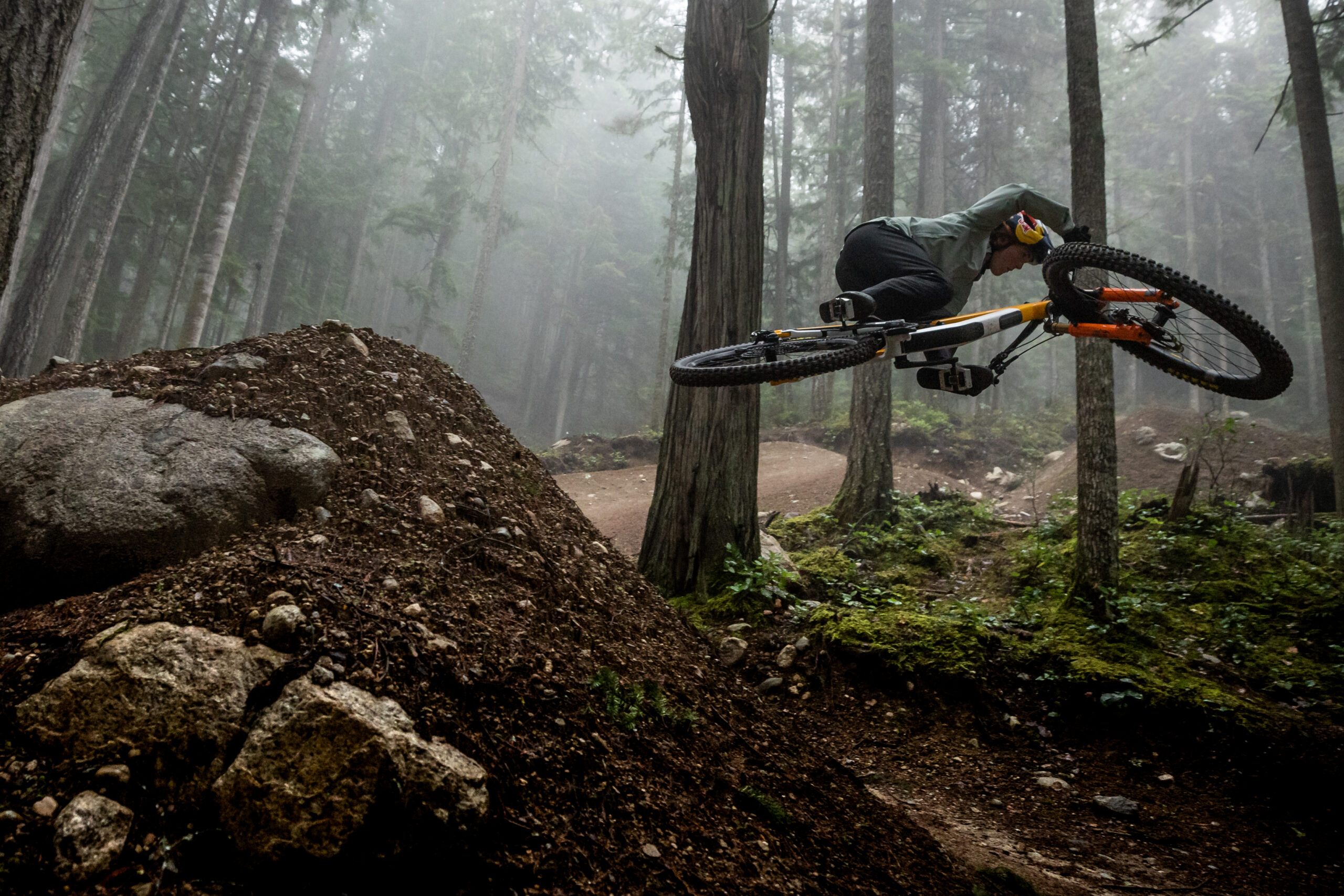
Both bikes also get the lower two tabs from an ISCG chainguide mount, with a custom-designed lower chainguide that wraps under the chainring to keep the chain in place. Unlike a lower guide with a roller, Norco’s setup doesn’t contact the chain under normal use. (It’s a similar-looking design to the Cascade Components lower guide, but with a co-molded rubber insert under the chain to keep things quiet.)
Norco offered the prior-generation Sight in both 27.5’’ and 29’’-wheeled versions, while the outgoing Optic was a dedicated 29er. The full 27.5’’ option on the Sight is gone, but both bikes can now be configured as either full 29ers or with a mixed-wheel size setup. Somewhat unusually, Norco accomplishes the change by swapping both the bolt-on lower shock mount and the rocker link. The idea is to accomplish both (1) the geometry changes needed to compensate for the rear wheel-size swap and (2) keep the suspension kinematics more consistent between the two setups.
Norco says they could accomplish essentially the same geometry by just changing the lower shock mount, but that doing so changed the leverage curve between the two configurations more than they wanted, and swapping both the shock mount and rocker link was the solution. Complete bikes and frames can be ordered with either configuration (though the details vary by region); “missing link” kits to swap to the other wheel size can be bought separately.
Norco also says that they’ve done a lot of work on the new bikes’ idler pulley to improve its durability and keep noise and drag to a minimum. The new Optic and Sight get a stainless steel pulley with a diamond-like carbon (DLC) coating; Norco says this new pulley is seven times as durable as the aluminum pulleys they’ve used on the Range and Shore. Their goal was to make the idler last as long as the chainring and cassette, and they claim that they’ve gotten there.
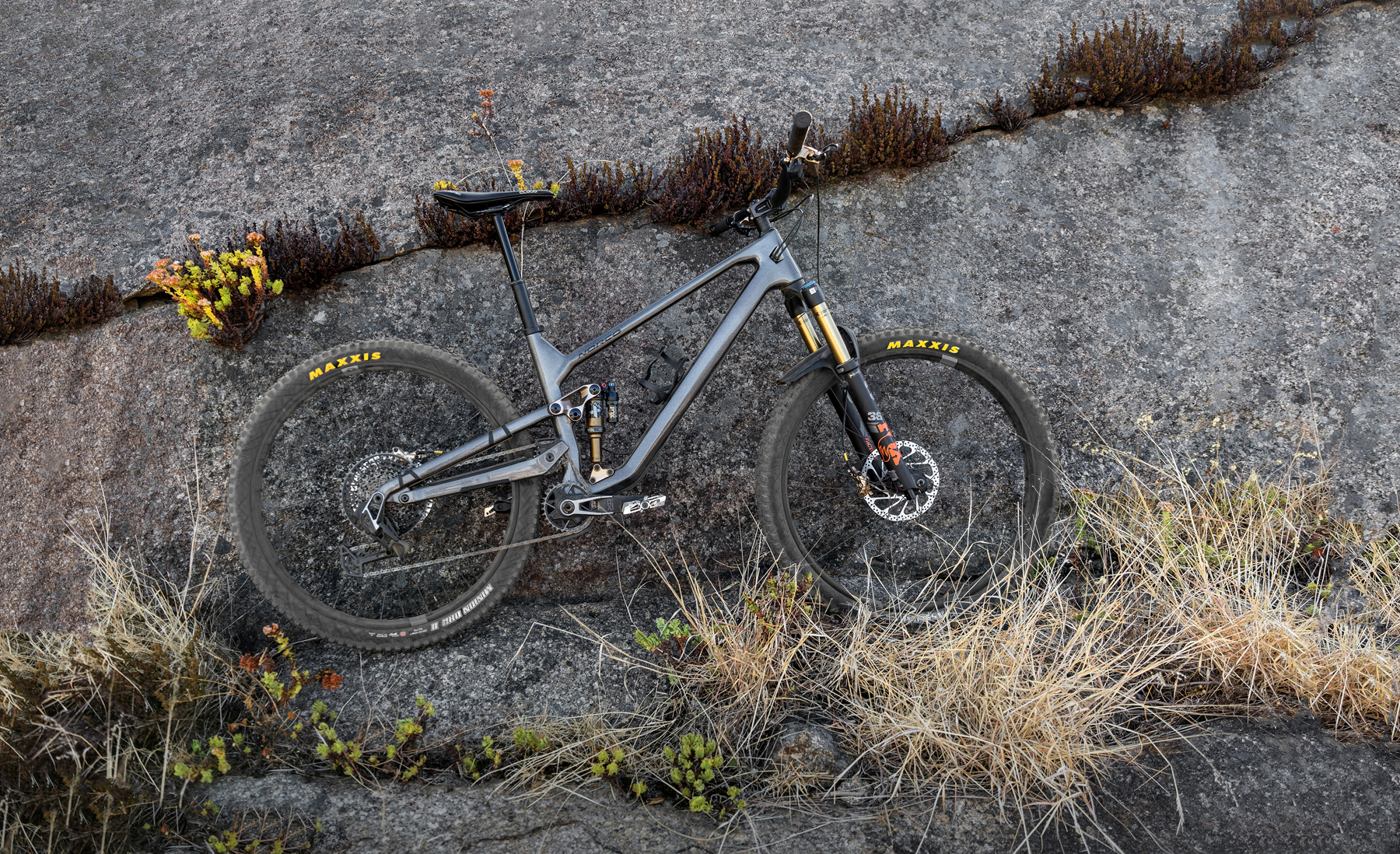
Along with the new frames, Norco has given their “Ride Aligned” setup guides a massive overhaul. In short, the new web app gives especially detailed setup recommendations, including suspension settings, tire pressures, and cockpit setup. They’re all based on not just your height and weight, but also user inputs for trail type, preferred suspension feel, and intended body positioning / front-to-rear weight bias. Once you’ve tried the baseline settings, the new Ride Aligned tool also gives options for how to tweak those settings based on what you feel on trail. E.g., if the fork feels soft relative to the rear shock, or the bike feels too planted / dead, and so on.
The new Ride Aligned tool is configured for all of Norco’s current models, not just the new Optic and Sight. It also allows you to create an account and save given settings configurations to reference later.
Fit & Geometry
Norco hasn’t made as dramatic changes to the geometry of the new bikes, relative to the suspension updates.
However, the new Optic and Sight are now offered in five sizes (now numbered 1 through 5), instead of the old Small / Medium / Large / XL scheme. The Size 5 frames are a little bigger than the old XLs, but Norco tightened up the gaps between sizes a touch as well, to make it easier for more folks to get a better-dialed fit, and give some riders more options to size up or down depending on their individual preferences.
Geometry: Norco Optic
The Optic keeps the 65° headtube angle of the prior-generation bike, but its seat tube angle has been steepened a little bit, to 77° effective on the Size 3. The larger sizes get a slightly steeper effective seat tube angle and the smaller ones are a touch slacker.
Reach ranges from 422.5 mm on the Size 1 through 522.5 mm on the Size 5, with 25 mm jumps per size. Norco has reduced the amount of bottom bracket drop a little bit, to 32 mm (from 38 mm), increased stack heights slightly, and shortened the static chainstay lengths a touch to compensate for the more rearward axle path on the new bike.
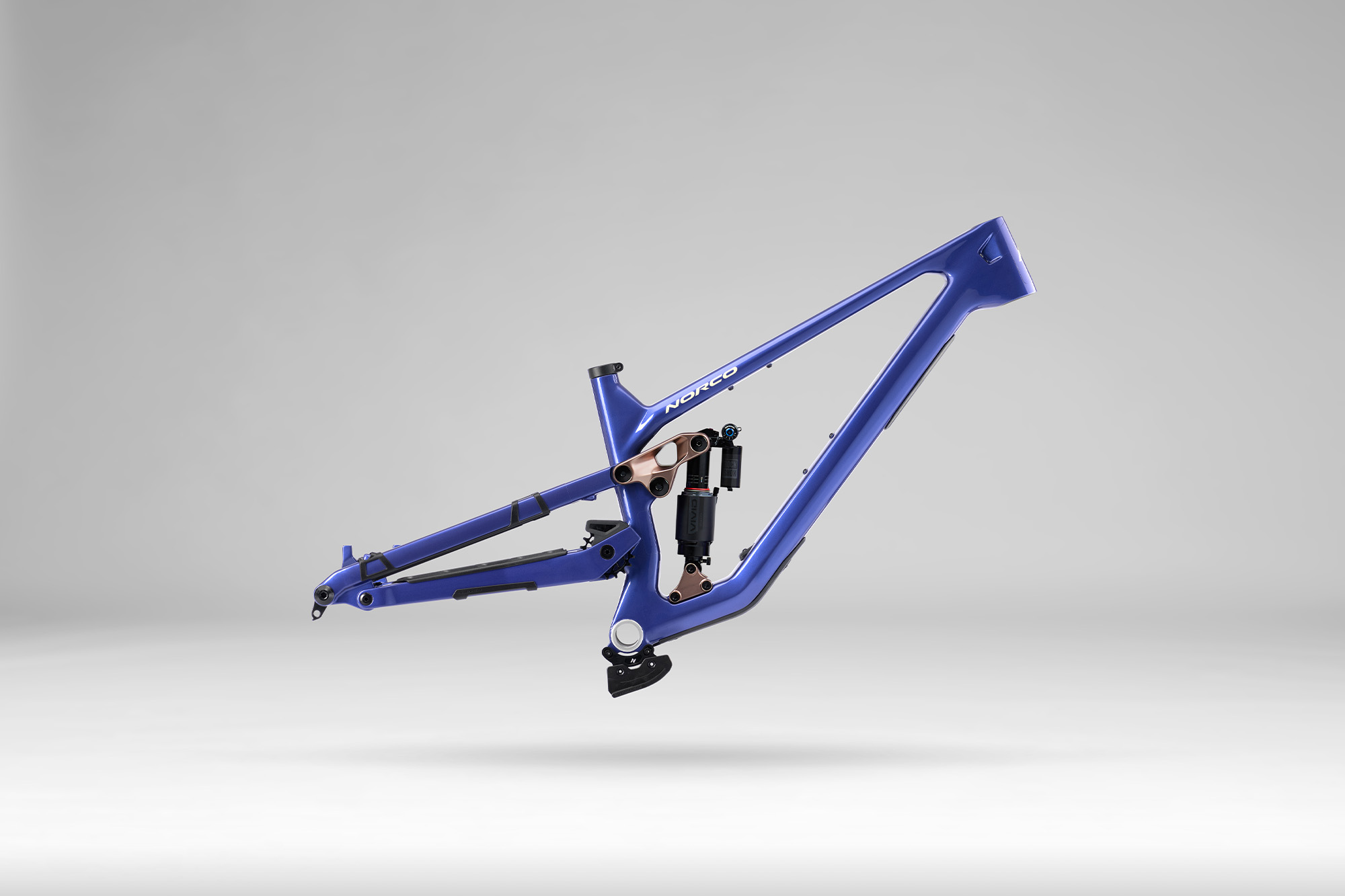
The chainstay lengths are still size-specific, and Norco says that the combination of slightly shorter stays plus a more rearward axle path produces a similar feel and balance to the old bike (by way of similar chainstay lengths at sag). The Size 3 Optic gets 429 mm stays when configured as a 29er. Those change by 4 mm per frame size (shorter on the smaller ones and vice versa). Converting the bike to a mixed-wheel-size configuration shortens them by 6 mm, though Norco notes that the initial axle path is more rearward in the mixed-wheel-size configuration, so the difference is less pronounced at sag.
Geometry: Norco Sight
The changes to the Sight’s geometry are even more subtle. The 64° headtube angle from the prior-generation bike carries over, and the seat tube angles are about the same as well (77.5° for the Size 3). The chainstays are once again shorter, but only slightly — the Size 3 gets 434 mm ones as a 29er, with the same 4mm-per-size jumps in a given wheel size as the Optic, and the same 6 mm reduction when set up with a 27.5’’ rear wheel. The Sight’s bottom bracket drop holds steady at 25 mm (that’s for the 29er version, or relative to the front wheel in the MX configuration).
If anything stands out on the geometry charts, it’s that Norco’s recommended sizing runs a bit bigger than average, especially in terms of the reach figures. E.g., at 6’ / 183 cm tall, I’m squarely in their band for the Size 4 frames, both of which have a 497.5 mm reach. The steep seat tubes on both bikes keep the effective top tube measurements in check, though, and my hunch is that they’re right to put me on the Size 4 for both bikes. We’ll be finding out very soon.
(BLISTER+ members can check out our Flash Review of the Optic for our early thoughts.)
The Builds
Norco is offering a ton of different builds on the Optic and Sight, though not all of the options are available in all markets. Canada gets the full host of options; builds with a price listed in USD are available stateside. Check Norco’s site for the options in your area if you live elsewhere.
Both bikes are also offered in both materials as a frame kit, which includes the frame, shock, chainguide, and your choice of link kit to run either rear wheel size.
The Optic A (aluminum) comes with a RockShox Vivid Select+ for $2,099 USD / $2,399 CAD; the Optic C (carbon) version gets an upgrade to a Vivid Ultimate for a total of $3,849 USD / $4,999 CAD.
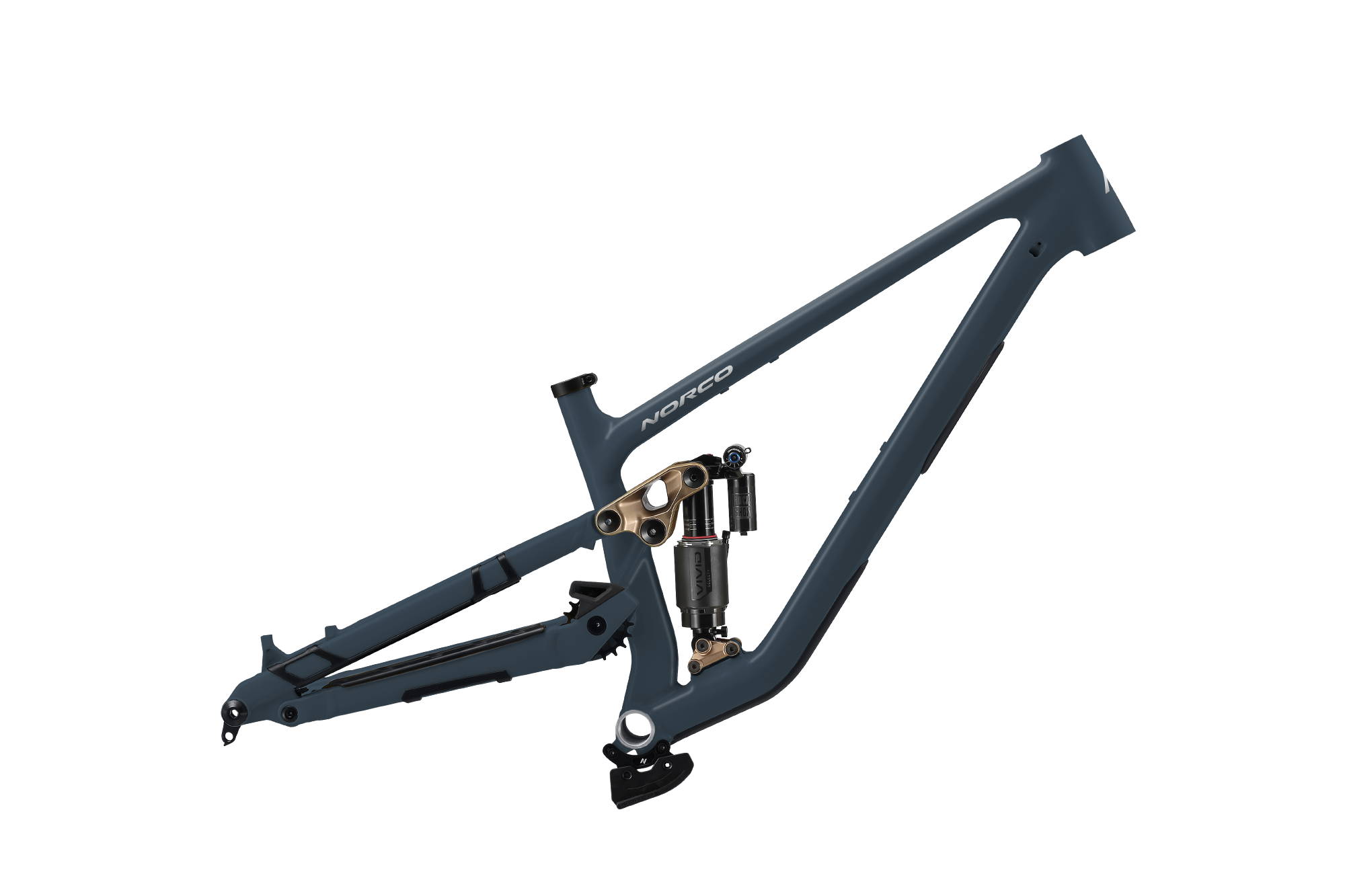
The Sight A frame comes with a Vivid Ultimate as well, for $2,399 USD / $2,199 CAD (which looked like a typo to us, too, but is apparently correct). The Sight C frame gets the same Vivid Ultimate shock for $3,999 USD / $5,149 CAD.
The highlights of the build specs are as follows:
- Drivetrain: SRAM GX
- Brakes: SRAM Level Stealth Bronze or TRP Slate Evo (w/ 200 or 203 mm front / 180 mm rear rotors)
- Fork: Fox 34 Rhythm
- Shock: Fox Float X Performance
- Wheels: Stan’s Flow D rims w/ Race Face Trace hubs
- Dropper Post: TranzX (Size 1: 150mm; 2: 170 mm; 3 & 4: 200 mm; 5: 230 mm)
- Drivetrain: SRAM GX Transmission
- Brakes: SRAM Level Stealth Silver or TRP Slate Evo (w/ 200 or 203 mm front / 180 mm rear rotors)
- Fork: RockShox Pike Ultimate
- Shock: Fox Float X Performance Elite
- Wheels: Stan’s Flow S2 rims w/ DT Swiss 350 hubs
- Dropper Post: TranzX (Size 1: 150mm; 2: 170 mm; 3 & 4: 200 mm; 5: 230 mm)
- Drivetrain: Shimano Deore
- Brakes: Shimano Deore 4-piston (w/ 203 front / 180 mm rear rotors)
- Fork: RockShox Pike Select
- Shock: Fox Float X Performance
- Wheels: WTB ST i30 rims w/ Shimano TC500 hubs
- Dropper Post: TranzX (Size 1: 150mm; 2: 170 mm; 3 & 4: 200 mm; 5: 230 mm)
- Drivetrain: SRAM GX Transmission
- Brakes: SRAM Code R (w/ 200 front / 180 mm rear rotors)
- Fork: RockShox Lyrik Select+
- Shock: RockShox Vivid Select+
- Wheels: Stan’s Flow S2 rims w/ Race Face Trace hubs
- Dropper Post: TranzX (Size 1: 150mm; 2: 170 mm; 3 & 4: 200 mm; 5: 230 mm)
- Drivetrain: SRAM GX Transmission
- Brakes: SRAM Code R (w/ 200 front / 180 mm rear rotors)
- Fork: RockShox Pike Select+
- Shock: Fox Float X Performance Elite
- Wheels: Stan’s Flow S2 rims w/ Race Face Trace hubs
- Dropper Post: TranzX (Size 1: 150mm; 2: 170 mm; 3 & 4: 200 mm; 5: 230 mm)
- Drivetrain: SRAM X0 Transmission
- Brakes: SRAM Level Stealth Silver 4-piston (w/ 200 front / 180 mm rear rotors)
- Fork: Fox 34 Factory Grip2
- Shock: Fox Float X Factory
- Wheels: We Are One Union rims w/ Industry Nine 1/1 hubs
- Dropper Post: OneUp (Size 1: 150mm; 2: 180 mm; 3 & 4: 210 mm; 5: 240 mm)
Note: Both wheel size options are available in Canada; only the MX is sold in the US
- Drivetrain: Shimano SLX
- Brakes: Shimano Deore 4-piston (w/ 203 front / 180 mm rear rotors)
- Fork: Fox 36 Rhythm
- Shock: Fox Float X Performance
- Wheels: Stan’s Flow D rims w/ Shimano SLX hubs
- Dropper Post: TranzX (Size 1: 150mm; 2: 170 mm; 3 & 4: 200 mm; 5: 230 mm)
Note: Both wheel size options are available in Canada; only the MX is sold in the US
- Drivetrain: SRAM GX Transmission
- Brakes: SRAM Code Bronze Stealth (w/ 200 front / 180 mm rear rotors)
- Fork: RockShox Lyrik Ultimate
- Shock: RockShox Super Deluxe Ultimate Coil w/ Sprindex spring
- Wheels: Stan’s Flow S2 rims w/ Race Face Vault hubs
- Dropper Post: TranzX (Size 1: 150mm; 2: 170 mm; 3 & 4: 200 mm; 5: 230 mm)
Note: Both wheel size options are available in Canada; only the MX is sold in the US
- Drivetrain: Shimano Deore
- Brakes: Shimano Deore 4-piston (w/ 203 front / 180 mm rear rotors)
- Fork: RockShox Lyrik Select
- Shock: RockShox Vivid Select+
- Wheels: Stan’s Flow D rims w/ Shimano TC500 hubs
- Dropper Post: TransX (Size 1: 150mm; 2: 170 mm; 3 & 4: 200 mm; 5: 230 mm)
Note: Both wheel size options are available in Canada; only the MX is sold in the US
- Drivetrain: SRAM GX w/ NX shifter
- Brakes: SRAM Code Bronze Stealth (w/ 200 front / 180 mm rear rotors)
- Fork: RockShox Lyrik Ultimate
- Shock: RockShox Vivid Ultimate
- Wheels: Stan’s Flow S2 rims w/ Race Face Trace hubs
- Dropper Post: TranzX (Size 1: 150mm; 2: 170 mm; 3 & 4: 200 mm; 5: 230 mm)
Note: Both wheel size options are available in Canada; only the 29er is sold in the US
- Drivetrain: SRAM GX Transmission
- Brakes: SRAM Code Silver Stealth (w/ 200 front / 180 mm rear rotors)
- Fork: Fox 36 Factory Grip2
- Shock: Fox DHX2 Factory w/ Sprindex Spring
- Wheels: Stan’s Flow S2 rims w/ Race Face Vault hubs
- Dropper Post: OneUp (Size 1: 150mm; 2: 180 mm; 3 & 4: 210 mm; 5: 240 mm)
- Drivetrain: SRAM X0 Transmission
- Brakes: SRAM Code Ultimate Stealth (w/ 200 front / 180 mm rear rotors)
- Fork: RockShox Lyrik Flight Attendant
- Shock: RockShox Super Deluxe Flight Attendant
- Wheels: Race Face Era rims w/ Race Face Vault hubs
- Dropper Post: OneUp (Size 1: 150mm; 2: 180 mm; 3 & 4: 210 mm; 5: 240 mm)
- Drivetrain: SRAM X0 Transmission
- Brakes: SRAM Code Ultimate Stealth (w/ 200 front / 180 mm rear rotors)
- Fork: RockShox Lyrik Flight Attendant
- Shock: RockShox Super Deluxe Flight Attendant
- Wheels: Race Face Era rims w/ Race Face Vault hubs or We Are One Union rims w/ Industry Nine 1/1 hubs
- Dropper Post: OneUp (Size 1: 150mm; 2: 180 mm; 3 & 4: 210 mm; 5: 240 mm)
Some Questions / Things We’re Curious About
(1) We’ve ridden a ton of high-pivot Enduro and DH bikes by now, but the Optic and Sight are going to be the two shortest-travel ones we’ve reviewed to date. How does the layout translate to these Trail bikes?
(2) The Norco Range is still one of the most stable and planted ~170mm-travel Enduro bikes we’ve ever reviewed, but it also doesn’t pedal all that efficiently. Norco seems to have targeted a pretty different set of performance characteristics with the new Optic and Sight, but how different have they really made their VPS HP suspension feel here?
(3) And do the Optic and Sight really feel like they have similar weight distribution in their respective 29’’ and MX setups, as Norco claims?
Bottom Line (For Now)
A lot of recently updated bikes have felt like they got a minor refresh but few major changes. That certainly does not appear to be the case with the new Norco Optic and Sight. We just got both in for testing so we’ll have much more to say about them soon, and we’re very excited to spend a whole lot of time on them ASAP. Stay tuned for Flash Reviews coming very soon, and Full Reviews later this year.
And for even more info on the new bikes, check out this week’s episode of Bikes & Big Ideas with Norco engineer, Colin Ryan.
Flash Review: Our Initial On-Trail Impressions
BLISTER+ members and those who purchase our Digital Access Pass can check out the Flash Review below to read our initial on-trail impressions. Get our Digital Access Pass to view all our Flash Reviews and Deep Dives, or become a BLISTER+ member today to get access to that and a LOT more, including the best worldwide Outdoor Injury Insurance, exclusive deals and discounts on skis, personalized gear recommendations from us, and much more.

